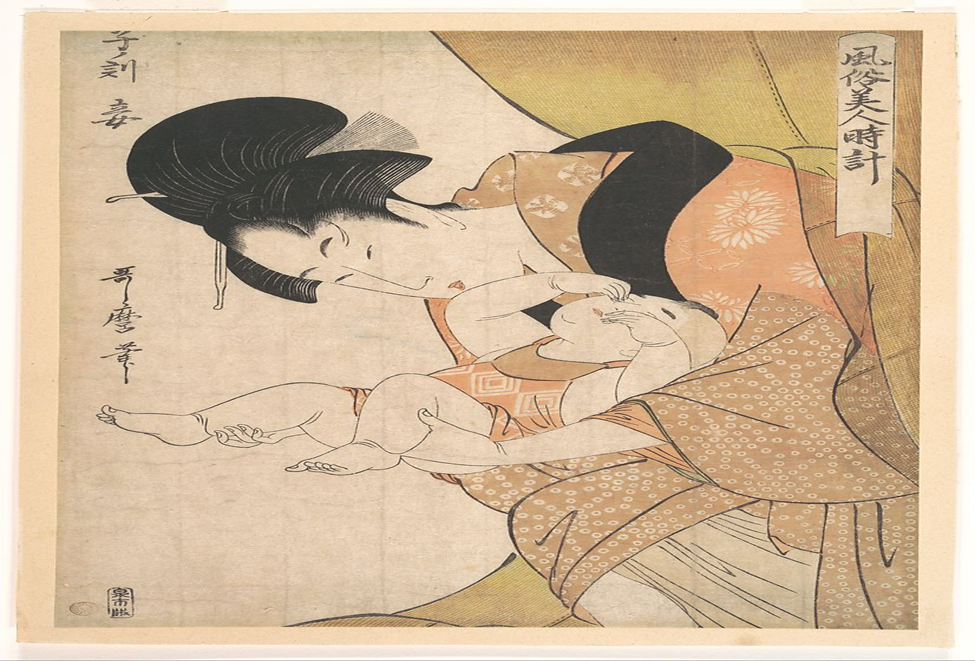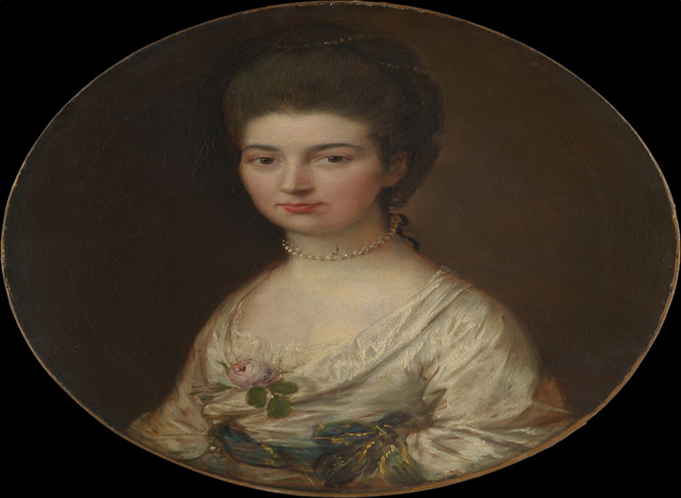Kitagawa Utamaro was one of the greatest Japanese artists who ever lived. Kitagawa was born in Japan in 1753 and died in 1806 after becoming one of the prominent artists of his time. He largely did drawings and woodblock portraits using different materials, but he is mainly known for his paintings of beautiful women in the 1790s when his artwork fame had reached its peak (Solkin, 10). After his drawings became famous, his works were appreciated beyond his country and reached Europe (Katz et al., 44).Utamaro is known for influencing the European impressionists who borrowed several ideas from his work.

The artist has a unique style of presenting his ideas although abstractly the artwork conveys strong emotional messages. The picture shows lonely and sad feelings because the mother and child look gorgeous but they are suffering because of being sleepy. The artist uses the shades of brown, white, and black with perfect harmony and precision to demonstrate abstract figures and visual illusions that synchronize with the Edo period (Solkin, 23). The shapes and lines that make this art bond and the different shades used make the artwork flow smoothly creating a harmonious pattern. The drawing intensively engages the emotions of the viewer because of the way the information is relayed. The artwork is made from woodblock print ink and color on paper. The drawing is approximately 14 3/8 x 9 5/8 in. (36.5 x 24.4cm), which are good dimensions for average-sized drawings (Solkin, 25).The Japanese words inscribed in the artwork helps the viewer to understand the origin of the piece of art.

Thomas Gainsborough who is regarded as one of the most prolific artists who ever lived was born in 1727 and died in 1788. He was an English printmaker, landscape and portrait painter, and draughtsman, and was considered to be the most important artist in the second half of the 18th century (Gainsborough & Russel, 11) He used to paint quickly and most of his works were characterized with easy strokes and palette. He is credited for the speed at which he applied paint while drawing from the observations of nature, more especially human environment (Solkin, 15). His paintings had poetic sensitivity and when the viewers looked at them, they were filled with emotions (Solkin, 15).The artist did not adhere to academic guidelines while doing his work. Thomas usually merged his figures of portraits with the background scenes behind them because he was enthusiastic about landscapes. Although he is recognized to paint portraits of men, he has the reputation of being a painter of fashionable women. Using his painterly method to present what he wanted, he was able to instill a feeling of aristocratic society to all the women, without considering their standing in in the social strata (Solkin, 19). This particular portrait shows a pretty woman who appears to be of a high social class. The woman in Mrs. Ralph Izard (Alice De Lancey) is expensively dressed and wears a pricey necklace, which raises her social status further.
Her gaze is directed right at the viewer who becomes fascinated by her enticing half-smile. Her white silken dress matches her shiny, smooth, and sparkling hair with the hands tucked below the waist (Solkin, 20). This portrait clearly shows Gainsborough’s aesthetic maturity in making refined and highly-detailed portraits of representing important people in society. The artist uses the shades of white and brown with well-crafted curves which bring out a clear picture of nobility. The visual illusions in the picture clearly match the emotions that the artist wants to create. The portrait’s magnificent appearance and the use of expensive and exotic materials will make the viewer be filled with emotions of admiration. The artist mainly used oil and canvas to accomplish his artwork which is approximately 30 1/4 x 25 1/8 in. (76.8 x 63.8 cm) and oval in shape (Solkin, 24). This work was done during the period when Europe was rising politically and economically at a high rate which affected the artistic industry. Similarities and Differences The two pieces of art appeal to the inner feelings of the viewers through their visual illustrations.
For instance, the work by Kitagawa Utamaro elicits sentiments by the way the woman in the drawing is presented (Katz et al., 50). Equally, Thomas Gainsborough makes emotional appeals through the way he elegantly and visually presents his portraits (Journals, 38). Besides, both artists mainly focus on women in their pieces of artwork.Kitagawa Utamaro portrays what was happening during the Edo period in Japan while Thomas Gainsborough shows the English culture. Therefore, the two artists are from two different geographical areas. Although, their works were done during different times, both regions were experiencing exponential growth socially and economically which positively influenced their works of art (Gainsborough & Russel, 39). Additionally, Thomas did portraits of women in higher economic strata and Kitagawa draws and paints the ones in lower social class. I chose the two pieces of art because they represent two deserve regions and cultures, which gives a broader impression of the artworks. Secondly, their works are about women who are the pillar in society, and learning how women were viewed gives a clear picture of the upper-class life. Finally, artists are prolific and champions in their fields; therefore, their works are of great importance.
References
Gainsborough, T., & Russel, P. (2016). Delphi complete works of Thomas Gainsborough (Illustrated). New York, NY: Delphi Classics.
Journals, U. (2018). Japanese art woodblock notebook No. 2: Japanese ukiyo-e style woodblock print notebook, journal book. Attractive 6×9 lined Japanese art blank book featuring traditional kimono women hairstyle. Kitagawa Utamaro. New York, NY: Publishing Platform.
Katz, J., Hatayama, M., Clark, T., Murata, T., Nagata, H., Nagata, S.,… Art Institute of Chicago. (2018). Painting the floating world: Ukiyo-e masterpieces from the Weston collection. Chicago, IL: Art Institute of Chicago.
Solkin, D. H. (2015). Art in Britain 1660-1815. New Haven, CT: Yale University Press.